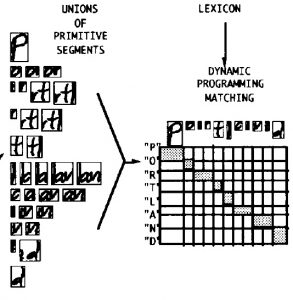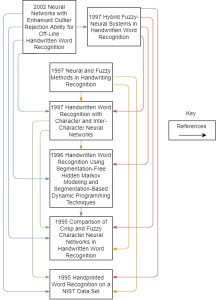Paul Gader started with Handwriting Recognition in 1989 by first looking at handwritten zip code recognition in mailing addresses. After zip code recognition, he expanded his research into analyzing handwritten word recognition.
One large problem faced with handwritten word recognition is the following paradox: we can’t read a word without knowing the characters in the word, but we also can’t read a character in the word without knowing the word. To solve this word-character paradox, a dynamic programming approach was used and compared to neural networks trained with crisp and fuzzy desired outputs (see 1995 journal articles, “Handprinted word recognition on a NIST data set” and “Comparison of Crisp and Fuzzy Character Neural Networks in Handwritten Word Recognition“). We observed that neural networks often produced high confidence outputs for patterns that were not characters and did not look like characters. This incorrect character identification could lead to word recognition errors.

This figure details the dynamic programming matcher. The matcher takes a word image, a string, and the word image primitives and returns a value between zero and one indicating the degree to which the word image represents the string.
Common dilemmas with handwritten recognition
1. Ambiguous Letters
Guess what the following letters are:
![]()
![]()
2. Ambiguous Letters vs. Numbers
Guess what the following characters are:
![]()
![]()
![]()
![]()
See the answers to the above ambiguous characters.
Related Papers
Much of the research in these publications was conducted in collaboration with Dr. Gader’s Ph.D. students.
|
1995 |
Handprinted word recognition on a NIST data setOne way to analyze handwritten words is to input a digital image and a lexicon (list of strings), then determine to what degree the image looks like a string from the lexicon. To perform this task, we used a Neural network for match scores, and dynamic programming to find the segmentation of the input image that yields the best match to a given string. |
|
1995 |
Comparison of Crisp and Fuzzy Character Neural Networks in Handwritten Word RecognitionThe purpose of this paper is to detail experiments comparing the use of neural networks trained with crisp and fuzzy desired outputs in handwritten word recognition. A handwritten word recognition algorithm using the neural networks for character level confidence assignment was tested on images of words taken from the USPS mailstream. The fuzzy outputs were defined using a fuzzy k-nearest neighbor algorithm. The crisp networks slightly outperformed the fuzzy networks at the character level but the fuzzy networks outperformed the crisp networks at the word level. This empirical result is interpreted as an example of the principle of least commitment. |
|
1996
|
Handwritten Word Recognition Using Segmentation-Free Hidden Markov Modeling and Segmentation-Based Dynamic Programming TechniquesThis paper focuses on two approaches to handwritten word recognition: segmentation-free and segmentation-based techniques. The segmentation-free technique constructs a continuous density hidden Markov model for each lexicon string. The segmentation-based technique uses dynamic programming to match word images and strings. The combination module uses differences in classifier capabilities to achieve significantly better performance. |
|
1997 |
Handwritten Word Recognition with Character and Inter-Character Neural NetworksBased on data images of addresses from the USPS mail, we conducted a variety of experiments: character recognition, compatibility recognition, and word recognition. Our word recognition algorithm employed dynamic programming, neural-network-based character recognition, and neural-network-based inter-character compatibility scores. A novel contribution to this algorithm was leveraging the inter-character information to gain significant improvement in performance. |
|
1997 |
Neural and Fuzzy Methods in Handwriting RecognitionThis article gives an overview of some challenges and applications of neural and fuzzy methods for recognizing handwritten words, numeric fields, and locating handwritten street numbers in address images. Fuzzy logic systems are advantageous in some situations because they can represent high- and low- level information. At a high-level, they can be used to find street number locations in address images, and at a low-level, they can encode character-class membership information. Using different methods combines information that might not have been available from using only neural or only fuzzy techniques. Therefore, by combining neural network techniques that generate fine decision boundaries and fuzzy logic techniques that handle coarser knowledge, we can achieve excellent results. |
|
1997 |
Hybrid Fuzzy-Neural Systems in Handwritten Word RecognitionA classic problem in image pattern recognition, is the inability to accurately segment a word. To segment the word, you encounter a paradox: it is difficult to segment without recognizing and it is difficult to recognize without segmenting. The research described in this paper is aimed at improving handwritten character classifiers for use in off-line handwritten word recognition. We examine two hybrid fuzzy neural systems, a self-organizing feature map, a multilayer perceptron, and a Choquet integral. The two systems are compared individually, but as a combination, the two outperform each other. |
|
2002 |
Neural Networks with Enhanced Outlier Rejection Ability for Off-Line Handwritten Word RecognitionThis paper focuses enhancing the outlier rejection ability on the multilayer perceptron (MLP), and a variant of the radial basis function network (RBF) with the goal to use them as character level. We cluster the data, and then create a RBF for each cluster in the Principal Component Analysis domain of that transformation. It was also trained with and without a regularization term that was aimed at minimizing the variances of the nodes in the hidden layer. Our test on combining the MLPs and PCA-RBF networks shows the potential to improve word recognition performance by exploiting the complement of these two kinds of neural networks. |
